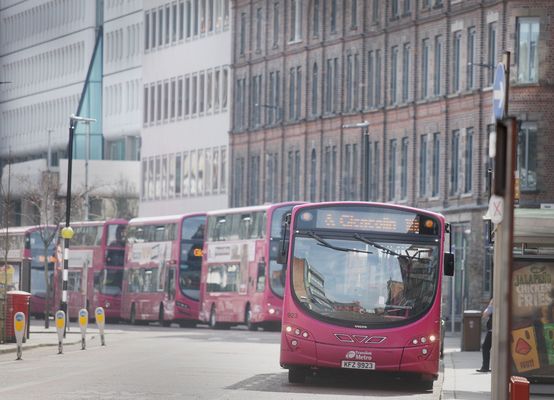THREE pivotal figures behind Ireland’s 1798 Rebellion are to be explored in an upcoming talk at Áras Uí Chonghaile.
The three figures which will be featured are Mary Ann McCracken, Samuel Neilson and Thomas Russell. The talk titled ‘The People Behind 1798’ will be held at the James Connolly Visitor Centre on the Falls Road on Wednesday 26 October at 7pm, and given by Seán Napier who hosts the popular Belfast’s 1798 walking tours.
Influenced by the French and American Revolutions, and Englightenment philosophy, the rebellion sought to unite those of Protestant and Catholic faith, and drive British rule from Ireland to establish a democratic republic. Lasting almost five months, the rebellion was eventually put down and many of the leaders including Henry Joy McCracken were executed.
Speaking ahead of next month's talk, Seán Naper said “We’ll be looking into the lives of three people, Thomas Russell, who although a Co Cork man, had great love for Belfast. Russell was a very important figure and was best friends with Wolfe Tone. Mary Ann McCracken was the sister of Henry Joy and was very close with all the leading figures of the rebellion, and also the Presbyterian Jacobin, Samuel Neilson.”
JACOBIN: Samuel Neilson was known as the 'Belfast Jacobin' because of his strong Republican politics
Seán’s talk will focus on the radical politics of these figures, and their effects on developing the ideas that led to, and carried out the rebellion, which was one of the most pivotal events in Irish history.
Speaking on the life of Samuel Neilson, Seán said: “Samuel Neilson was a very important figure in republican circles in Belfast at the time. He ran the United Irishmen when Wolfe Tone wasn’t around. Tone was largely an overseer but people like Thomas Russell and Neilson were the ones who really ran things on the ground.”
MEMORY: Mary-Ann McCracken, pictured here in later life was responsible for keeping alive the memory of 1798, and was also a prominent campaigner against slavery.
As well as exploring the effect these people had on the city of Belfast during the 1790s, Seán will also focus on their relevance today and how they have influenced thinkers, poets and revolutionaries who followed after them. Seán explained it was Wolfe Tone who first coined the phrase of Belfast being the ‘Athens of the North’, and how his, and the other writings of the United Irishmen were so brilliantly written they have continued to influence poets for generations.
Speaking of their literary influence, Seán said: “Tone’s writing was full of wonderful imagery, and he used nicknames and alternative names for most of the places. He referred to Belfast as ‘Blefuscu’, which is an island nation in Gulliver’s Travels by Irish author Jonathan Swift. Swift apparently got the influence of the giants in his book from the outline of Cave Hill in Belfast. Tone really imbued Belfast with mystique. He also referred to Thomas Paine’s 1791 ‘Rights of Man’ as ‘The Quran of Blefuscu’ which shows you how much influence the book had on the United Irishmen.”
REPUBLICANISM: Thomas Russell and Henry Joy McCracken were pivotal in creating mass support for the rebellion.
However Seán’s talk will be primarily focused on the three figures of McCracken, Neilson and Russell, and will go into how Russell led the drive, along with Henry Joy and Mary Ann McCracken, in taking republicanism to the masses and converting them to the cause of the United Irishmen.
I think this would be Wolfe Tones view on the #Census.
— Seán Napier (@Seanofthesouth) September 22, 2022
"To unite the whole people of Ireland, to abolish the memory of all past dissensions, and to substitute the common name of Irishman in place of the denominations of Protestant, Catholic and Dissenter -
these were my means" pic.twitter.com/v9ST5Xu6y4
“Russell and the McCrackens were the ones converting people to republicanism. The people loved them, they would come to people’s homes and speak with them, and they inspired many passionate ballads and poems about their activities such as ‘The Man From God Knows Where’ written by a Bangor woman Florence Wilson. Russell was also renowned at the time as a very good looking man, and worked as one of the first librarians at Linen Hall Library. We’ll talk about the personal relationships between the figures, about how we believe Mary Ann McCracken was in love with Russell. She spent a lot of money defending him, and paid for his gravestone after he was executed in 1803 following Emmet’s rebellion.
“When he comes to Neilson, Wolfe Tone called him the ‘Belfast Jacobin’ after the French Jacobins in the French Revolution because he was such a hardline republican. The reason people are still so fascinated by 1798 is because when you read about these people, it really gets under your skin. I think their ideas are still as prevalent today as they ever were. Their idea of non-sectarian republican politics has influenced Irish thinkers over the centuries from the Young Irelanders, to the Fenians, to Patrick Pearse and Bobby Sands. Everybody always refers back to the leaders of 1798.”







